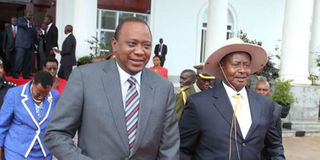Kenya-Uganda crude oil pipeline on shaky ground, firm explores alternative route

President Uhuru Kenyatta (left) with Uganda President Yoweri Museveni at Entebbe State House, Uganda. Uganda signed an agreement with Tanzania to build a pipeline to Tanga. Trouble is, Kenya had earlier signed an MoU with the same Uganda to build a pipeline to route their oil through northern Kenya to Lamu.
What you need to know:
- President Uhuru Kenyatta and Yoweri Museveni gave a directive settling on the Northern route through Kenya as the least expensive route.
- Total’s position on the pipeline could further extend the first oil production timeline beyond 2020.
- Sources in Uganda however say the state is not involved in discussions led by the oil companies.
- When completed the Kenya- Uganda pipeline will be the longest heated crude oil pipeline in the world.
The prospect of a joint crude oil pipeline between Kenya and Uganda seems to be standing on a shaky ground following a plan by a French firm to explore an alternative route.
Total E&P Uganda says it is working on its preferred route through Tanzania to Tanga despite a firm directive by the two heads of state.
President Uhuru Kenyatta and Yoweri Museveni gave a directive settling on the Northern route through Kenya as the least expensive route.
But the French-based multinational seems to have a different idea and ready to push for what it says is the most viable route. Total’s position on the pipeline could further extend the first oil production timeline beyond 2020.
“We are exploring all technically and economically viable options, Tanzania is among the options. We are currently at the stage of studying and investigating the Tanzanian route,” Ms Ahlem Friga Noy, the corporate affairs manager of Total E &P Uganda told Smart Company on phone but refused to divulge more on the issue.
Speaking during the Uganda International Oil and Gas Summit last week, oil company officials representing UK’s Tullow Oil PLC, France’s Total E&P and China’s Cnooc reiterated that they were pushing for a feasibility study on the Tanga route.
Total says the argument behind the Tanga route is that Kenya is faced by insecurity challenges. The Lamu route, the firms add, could be cheaper, offering better commercial terms to the users.
While adopting the Northern route, Uganda gave Kenya four conditions — tariffs, security, financing and no further delays. The conditions were set by the Ugandan oil companies which are doing a feasibility study on the Tanga route.
Total’s senior vice president for Eastern Africa, Javier Rielo met with Tanzania’s President Jakaya Kikwete in August and discussed the possibility of building a crude oil pipeline from Hoima to Tanga.
Since the proposal sits well with Tanzania’s ongoing preparatory works to upgrade Tanga port’s capacity to offload petroleum products, President kikwete supported it.
The three investors are equal partners in Uganda’s upstream sector. So far the investors are working on proposals that would bring out the best deal for the 6.5 billion barrels of oil in Uganda. Of the amount, 1.4 billion have been confirmed as recoverable.
Their interests in the $4 billion Kenya–Uganda oil pipeline could scatter Kenya’s dream of producing its first oil any time soon.
Kenya is, however, sticking to the deal by Presidents Kenyatta and Museveni.
“We know that the decision taken by the two heads of state is official, we are working together and moving on. We are trying to meet all the four issues, so that we can have a common way,” said Daniel Kiptoo, petroleum legal advisor for Energy Cabinet secretary.
Mr Kiptoo said the consultant Toyota Tsusho, approved by the two countries engaged with the oil companies in Uganda as the pipeline design was done.
“Their fears were brought on board and addressed before the crude oil pipeline route was adopted,” he said.
Sources in Uganda however say the state is not involved in discussions led by the oil companies.
Mr Ernest Rubondo, the head of the petroleum directorate, Ministry of Energy & Mineral Development in Uganda, confirmed there are considerations for the Tanga route.
He said that the country had agreed to the Lamu route as reflected in the MoU that Kenya and Uganda signed during President Kenyatta’s recent visit to the country.
Nonetheless, concerns raised by Uganda means that the Tanga route is a possibility.
Uganda, Mr Rubondo said, is going ahead to commission a feasibility study on Tanga, though “it will be for benchmarking and comparative purposes” against the Northern Kenya route.
Uganda seems to be torn between the oil investors and maintaining the good relationship with Kenya. Already, there is a committee consisting of both Kenyan and Ugandan officials to ensure Kenya is working on the set conditions.
In the likely event that Kenya continues to show laxity over meeting the set conditions on time, efforts on the oil pipeline through the Northern route could be stalled.
It is not clear what Uganda’s stand on the pipeline route is.
Uganda’s Principal engineer of refinery project at the Petroleum Directorate Stephen Enach said, “The committee on Kenya- Uganda oil pipeline is working to harmonise conditions set by Uganda on the crude oil pipeline so that the project can go forward.”
Mr Enach’s sentiments come after Kenya took Ugandan officials on a Lamu Port Southern Sudan-Ethiopia Transport (LAPSSET) Corridor tour on the first week of September.
The tour was to convince Uganda that there are ground works ongoing on the contested route.
“We have also agreed that security people should be brought on board so that as we speak as energy people we will bring experts in security and finance to help address conditions set by Uganda,” said Mr Joseph Nyaga who is in charge of the Northern Corridor Integration Project Authority in Kenya.
The agreement came after Uganda had proposed that Kenya must first meet conditions set on the pipeline before construction begins.
“We have to fulfil these conditions, we are at the stage of conducting a route survey, weighing all the options by Uganda, every issue is being addressed as we go along,” said Mr Kiptoo.
He revealed that Kenya- Uganda pipeline will be the longest heated crude oil pipeline in the world. However, Mr Kiptoo mentioned that the team is studying world heated pipelines such as the 670km long Mangala Development Pipeline (MDP) through India and the Cameroon — Chad West Coast pipeline.
It is ironical that Uganda is advocating for urgency in the pipeline construction yet it has brought up so many issues that are dragging behind the crude oil pipeline talks.
The final design adopted by the two countries (design by Toyota Tsusho) recommending the Northern route, states that Uganda and Kenya are currently supposed to be negotiating for a designer to do the detailed design on the actual construction of the oil pipeline, ‘The Front End Engineering Design (FEED).’
The FEED is the actual design that will state the real cost of the pipeline currently estimated at US$4 billion. Also, the design will dictate the tariffs/transit fee of oil per barrel and what each country will bear in terms of costs of construction.
However, Kenya is at the stage of convincing Uganda that the Northern route is economically viable and that they can meet pre-conditions set by Uganda on the crude oil pipeline.
The two countries should be making the key decision that will open up financing and dictate construction of the pipeline.
Uganda oil investors Tullow Oil Plc, Total and Cnooc Ltd together with Kenya’s Tullow Oil and Africa Oil are expected to deliberate on this and make a final decision by October 2017 according to the Toyota Tsusho final design on the oil pipeline.
It is however unclear how these investors will come together and sit down if scuffles have begun at such an early stage.
Governments of Uganda and Kenya have a production sharing contract with respective investors. Under the contract, investors will declare the actual cost of the oil pipeline and how to share the proceeds.
Uganda initially insisted on the Hoima-Eldoret-Lamu/Mombasa route arguing that it increases the value of its resources. Further, Uganda said the Northern route adds an extra 900 kilometres to the coastline.
Uganda expects its first oil refinery to start operations by 2018, the facility will have an initial capacity of 30,000 barrels per day, the aim being to reach 60,000 barrels by 2020.
The refinery project will further help Uganda develop its recently discovered oil deposits to reduce imports through domestic production.
It is this refinery that is in the thoughts of Uganda even as investors tear up Kenya’s dream to have the pipeline on the Northern route. Uganda stands to lose nothing if it drops the Northern route.





